Together, the popularity of the parks and Utah’s drive to bring visitors to the Mighty Five — Arches, Bryce, Canyonlands, Zion and Capitol Reef — is threatening the very way of life that brought people here in the first place.
Special Report: Utah’s ‘Mighty Five’ put the squeeze on Moab, Springdale
MOAB — More than 5 million people will visit Zion and Arches national parks before the year is over, bringing their money to dine in area restaurants, stay in hotels and fill up at gas stations.
It’s a boon to the local economy, pumping money into city budgets and keeping property taxes among the lowest in the state in surrounding areas. But the tourists also bring their trash, their vehicles, their noise — even their excrement.
In the gateway communities of Moab and Springdale, the story is traffic and a lack of affordable housing as permanent residents compete with the visitors. That lack of housing has brought perhaps the biggest unintended consequence: difficulty luring teachers, public safety officers and others that make up the backbone of a community.
Together, the popularity of the parks and Utah’s drive to bring visitors to the Mighty Five — Arches, Bryce, Canyonlands, Zion and Capitol Reef — is threatening the very way of life that brought people here in the first place.
“When the population of a community is only 5,000 people and on any given weekend you go to 15,000 to 20,000 people, there are obviously going to be impacts,” said Moab Mayor Dave Sakrison.
The parks themselves are straining under the weight of record visitors — more than 80,000 people visited Zion National Park over Labor Day weekend, topping 2015 numbers. And the crowds didn’t stop after the holiday. September recorded record crowds, and October continues to draw visitors through the third week of the month and the traditional Utah Education Association convention break.
In Springdale, a gateway to Zion National Park, the 3.5-mile Main Street is crammed with cars that often overflow into residents’ driveways and impede everyday business.
“For the first time in my life since I’ve been here, and I’ve been here since 1972, over Memorial Day weekend I was pulling out of church and the line was backed up 2 miles,” said Springdale Mayor Stan Smith.
“I was waiting for someone nice enough to even let me in line so I could get home.”
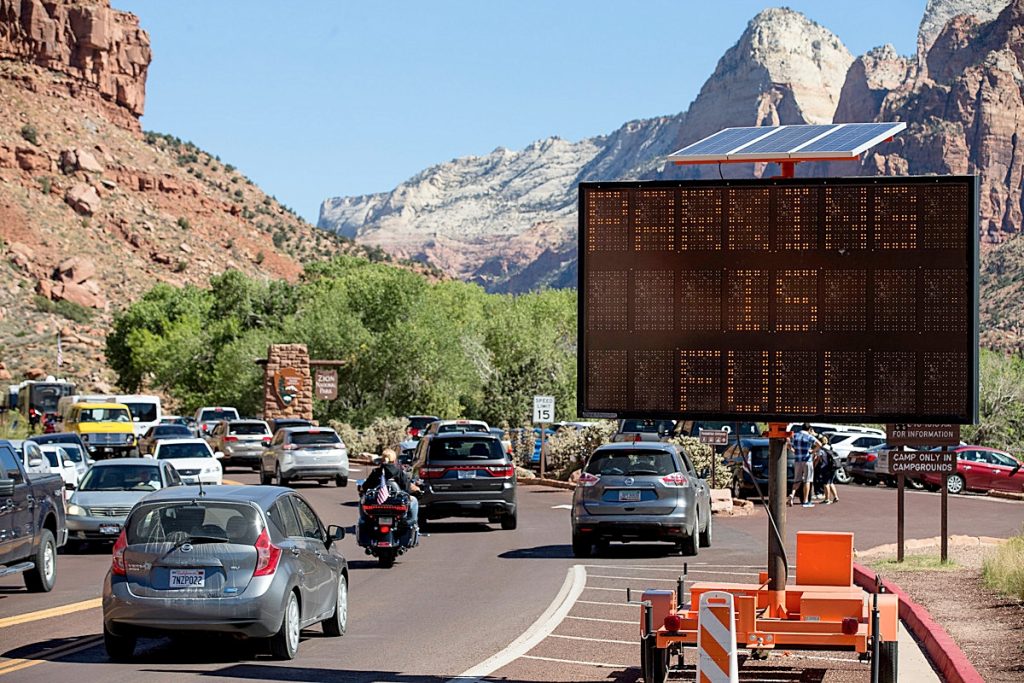
It’s not always like that, of course.
“Traffic and parking are not a problem absolutely every day,” Smith said. “But when it is a problem, it absolutely is a problem.”
Thomas Dansie, Springdale’s director of community development, said traffic counts taken the Saturday before Memorial Day over three separate years illustrate the growing problem of congestion.
In 2007, there were 1,283 vehicles that lined Main Street and commercial parking lots. By 2015, there were 1,512 vehicles along that same street, and this year, 2,342 occupied the same spot.
The street’s dimensions haven’t changed.
“It creates incredible angst,” Dansie said. “The residents of the town cherish what we call the village atmosphere, or the village character of the community. The idea is that Springdale is this small, slow-paced community that is compatible and complementary to the feel of Zion National Park. When you have that many vehicles parked alongside that road for 3.5 miles, it greatly detracts from that village atmosphere.”

Dealing with vehicles
Springdale leaders, Washington County officials, national park authorities and a consortium of other groups are trying to figure out where to put all the vehicles and if there are ways to park them somewhere else, outside of town.
“We don’t see a silver bullet,” Dansie said. “We recognize that this is a complex problem that will require a multifaceted approach.”
Being a destination town reveals all that is good about being a place everyone loves to visit, and all that is bad in trying to support that popularity.
More than a half-million people visited Zion National Park in June, and so far this year, nearly 2 million tourists entered the park.
“I am not really the mayor of 554 people,” Smith said. “My budget is close to that of larger communities like Santa Clara, Ivins.”
Property tax receipts in Springdale, both personal and commercial, generate $60,000. The town, in fact, has the lowest property taxes in the state, Smith says, because it can afford to, and Moab doesn’t have a city property tax at all.
Springdale’s budget is just over $3 million, generated from tourism.
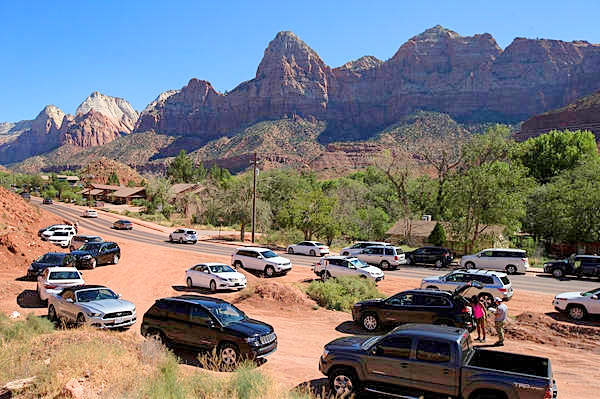
“That $60,000 is a pittance,” Smith said.
Since 2007, Springdale’s transient room tax revenue has tripled and overall, Washington County has seen a $5 increase in the average daily rate charged at hotels from the year before — meaning not only are more people coming to visit, they’re spending more during their stay.
A new Marriott hotel is under construction in Springdale, and with it will come the need for new employees.
Both Moab and Springdale leaders say finding workers is one of the toughest challenges they face.
“Almost every restaurant is begging for people,” Smith said. “People come into town, it is really crowded, but they expect quick service.”
Colin Fryer, who owns three older hotels in Moab and the Red Cliffs Lodge, employs 160 people and has turned to an international pool of employees to fill his job vacancies.
At a job fair in the Philippines, he hired 80 people in two days. But because of a nationwide crackdown on immigration, he was only able to bring three people to Grand County on a work visa.
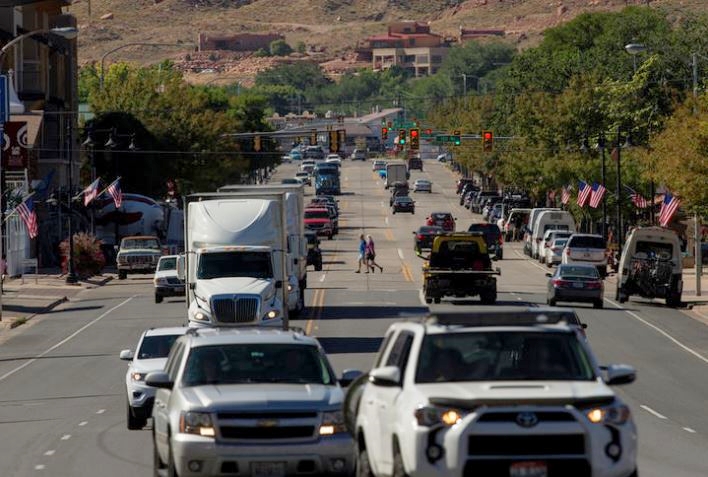
“It’s tough,” he said. “I can get you a job in this town by noon.”
On a weekday night after Labor Day in Moab, patrons crammed into restaurants. Harried workers apologized for slow service, bewildered at the “late” season crush of people.
“I can’t really describe it,” said Jodi Rupp, the revenue and fee business manager at Arches and Canyonlands national parks. “September has been incredibly busy.”

Each month this year, visitation at Arches was 10 percent higher than 2015, but September numbers skyrocketed to 20 percent higher than last year, she said.
“We’ve had traffic to the highway every morning,” Rupp said.
Fryer, a rancher turned hotelier who serves on the Moab Travel Council, said each year the tourist season gets longer.
“Ten years ago October was pretty quiet. Now, October is almost as busy as September.”
‘Throttle down’
With busy comes pressure. Both Springdale and Moab are investing in multimillion dollar infrastructure projects to modernize and keep pace with demands on sewage and water systems.
In Moab, the use of all terrain vehicles and side-by-side utility task vehicles on city streets prompted the “Throttle Down in Town” campaign to stem the noise in local neighborhoods.
“There is a lot more motorized recreation going on here, and that contributes to the quality of life situation as well,” Sakrison said. “The street I live on used to be a quiet little street, and now it is more of a collector street for the highway or the Slickrock Trail.”
Moab was once known as the uranium capital of the country, supplying a steady stream of ore to be transformed into yellow cake for the nation’s nuclear program.
The Cold War turned Moab into a hot commodity, but when the uranium bust came, the once rollicking economy collapsed.
“We were obviously a pretty depressed community,” Sakrison said. “There was a town meeting and leaders decided pretty much to pursue tourism. To me it was always meant to be a stopgap because we had learned the lesson of putting all your eggs in one basket.”

With its spectacular red rock scenery and proximity to two national parks and Dead Horse State Park, Moab has always been a draw for adventure seekers.
Sakrison believes that the Utah Office of Tourism’s successful Mighty Five campaign promoting the national parks in Utah cemented Moab’s tourism economy.
“You can’t close the door. The door got opened,” he said. “But you can try to manage it. That is what you can do. We have tried. We have been successful in some respects and other respects we have not. I worry about that. I worry about the quality of life for the people who live here year-round.”
Housing crunch
The Moab area is in the thralls of an affordable housing crisis, propelled by a number of factors that include zoning ordinances that discourage high-density development, and the proliferation of vacation homes and overnight rentals that promise property owners quick and easy cash, but take inventory away from the locals.
“You’d be hard-pressed to find anyone who has not been impacted by the housing crisis,” said Rhiana Medina, executive director of the Moab Valley Multicultural Center.
The nonprofit helps minority communities and at-risk residents by providing a variety of services, including helping individuals and families find stable housing.
Medina, who began volunteering at the center in 2010, said it took her nearly four months to find a place to live. She worked three jobs for five years to afford housing.
“I have a personal connection to the housing shortage.”
The national parks and other employers struggle to recruit workers, with the challenges of affordable housing cutting across the majority of occupations, impacting recruitment of schoolteachers, police officers and nurses.
In Springdale, many people can’t afford the housing, and in Moab, there’s little housing to be had.
“There is a great sense of urgency,” said Zacharia Levine, Grand County’s director of community development.
“A few years ago the folks who were feeling the greatest pinch on affordable housing were the service workers making low wages. One of the things that has changed is that folks in every single strata are now feeling the impacts, and you are struggling to find employees who are willing to be here.”
Levine said zoning ordinances designed to preserve the “rural” feel of Moab worked against housing affordability.
“In our community there is still a strong desire for single family detached dwellings,” Levine said, adding they comprise 70 percent of the housing stock.
Levine said the area has a few apartment complexes, but not many, and there is an extreme gap in mid-density housing such as duplex units or six- to 12-unit housing options.
“There is this term called the missing middle.”
Those who want to live and work in Moab face tough choices.
“Our best guess is that we currently have 1,000 households that are cost-burdened, paying more than 30 percent of of their income toward housing,” Levine said. “In terms of keeping pace with current population and the trends, we are another 500 units short of what we need today. There are a lot of families that are doubled up.”
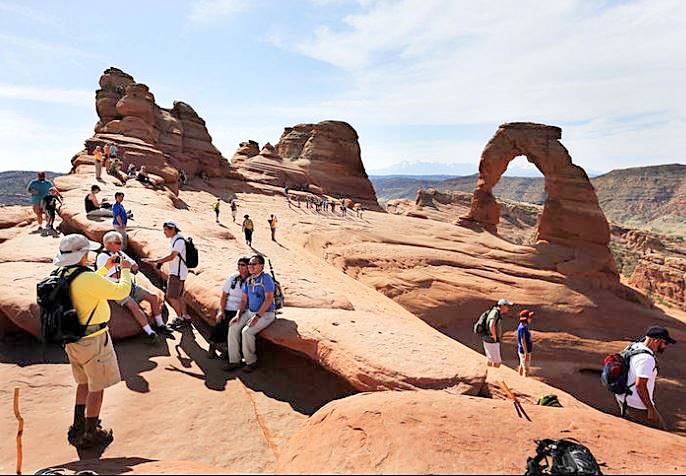
Housing the workforce
A quarterly report for the first part of 2016 by the Moab Chamber of Commerce illustrates the problem, pointing to signficant hotel and resort growth that contributed to $15 million in commercial development.
With new business comes new workers — 70 percent of the area’s workforce is employed in the entertainment and leisure industry — but housing is not keeping pace.
Levine said the proliferation of short-term rentals for vacation getaways is making the affordable housing issue even more complicated for the Moab area.
“Second and even third homeowners are coming in and and purchasing dwelling units for commercial purposes,” he said. “We need to be able to retain some housing for long-term permanent residents or we won’t have any long-term permanent residents.”
Some communities have moved to restrict overnight rentals, prompting a Utah lawmaker to introduce legislation this year that sought a yearlong moratorium on cities taking any action to regulate them.
The Grand County Council strongly objected to the proposal, citing the explosive growth in short-term rentals over a decade, jumping from 3.4 percent of the housing stock to close to 30 percent.
“There was a laundry list of reasons why the legislation was a bad idea,” Levine said. “Right now we have some pretty good regulations governing our rentals, and we simply want to retain our ability to zone for them. It is not about removing all short-term rentals or preventing the construction of new short-term rentals. It is about preserving and building our housing inventory for our full-time residents and workforce.”
The legislation restricting a city’s ability to control short-term rentals never made it out of committee, but Levine is fearful it could re-emerge.
“The impact that would have on Moab’s housing market is unfathomable,” he said.
While lack of affordable housing is a problem plaguing most communities, Levine said Grand County’s status as a destination for tourists makes the challenge worse. In Springdale, it is the same for the resort community, with many workers forced to travel to their jobs from LaVerkin or even St. George.
“I would be hard-pressed to find a community across the country that does not have a housing affordability problem,” Levine said. “Grand County’s is exacerbated by our economic profile due to the tourism industry.”
Levine said that over the years, there was community resistance of high-density housing in the Moab area, but that is starting to change.
“The reality is that for a long time, for decades, the goal was to preserve the rural character in Moab and Grand County. What that meant to most people is low density.”
It also means expensive housing.
Approximately 95 percent of all real estate listings for homes in the Moab area are out of reach for moderate income families, a community dynamic that Levine says threatens the future of the region if leaders don’t act to prioritize affordable housing.
“Housing is economic development if you think about it. You cannot continue to grow your economy without providing housing for your workforce.”
Elected leaders have dusted off an affordable housing plan from 2009 and formed an inter-local task force to dive headlong into the issue.
In Springdale and Washington County, community members are looking at a number of options to confront the problems that come with so many cars and recreational vehicles, including the possible construction of a parking garage and bus service for employees who work in town but live elsewhere.
In both towns, there is optimism the challenges can be overcome.
“There are no panaceas in the realm of affordable housing,” Levine said. “But if we want to continue to evolve as a community in positive ways, we are going to need to overcome the housing crisis. And we are doing that.”
Amy Joi O’Donoghue

*Free Range Report*

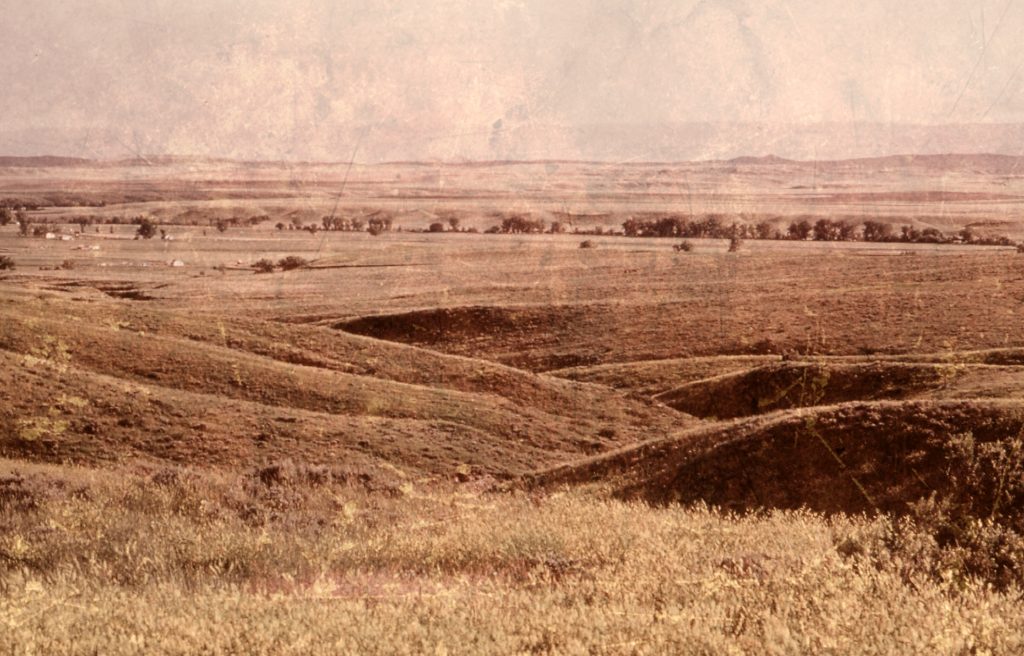

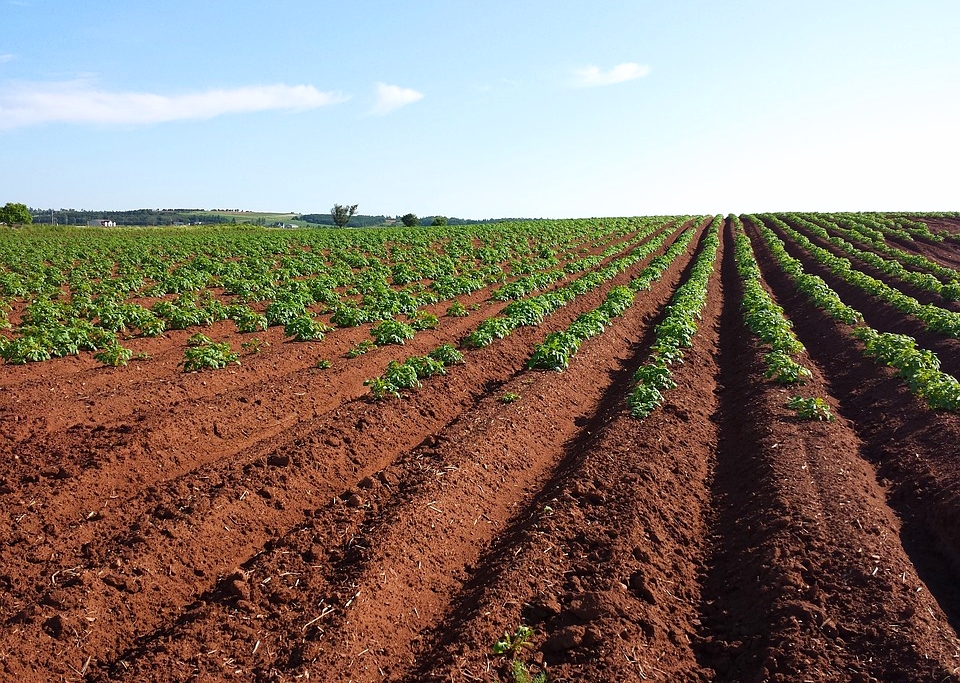
With all the turmoil, landscape impact, and chaos generated from highly successful tourism promotions, remind me again, why we think making another gigantic National Monument will “protect ancient ruins, and pristine landscape of San Juan County, Utah. It will be the worst idea the Conservation Lands Foundation of Durango, Colo and Terry Tempest Williams have ever thought of.
Janet, I just want to say, Bless your pea picking heart for being a voice of reason among all the turmoil and chaos. Yep, lets lock away 1.9 million acres of majestic, unspoiled, pristine land in San Juan county so the Federal government can protect it by unleashing hoards of mindless and wreckless tourists to destroy it. I will never ever accept such a travesty of justice. Not now. Not ever. Michael Nielson Lyman.
We are seeing a huge increase in the destruction of the natural resources that border the dirt roads around Moab…especially in the parks…roads are widening…people driving off the roads…old growth junipers dying from being run over…I work in the parks and see these roads everyday, and we need to work on education and resource protection…the NPS is under funded, and needs public support on these issues
Please get pictures of such damage, if possible, and send them with brief descriptions to editor@18.223.241.71 We agree that our natural treasures are at risk and must be managed differently.
I work in hospitality and have always been offended when my job is sneered at as low paying or unworthy compared to an industrial job or higher skilled professions. The growth should be welcomed and leveraged to pay for the improvements needed to enjoy it. Why would you have such low property taxes? You would be better off just wasting money than deciding not to collect a reasonable tax. You can’t convince me there are no developers willing to build lower and mid income housing, high density, low density, semi porous scaleable density housing, parking, transportation, shopping. You can send kids from these communities to Ivy League Universities, but they won’t come home unless you give them thriving attractive, unique home towns to come back to. So many jobs have become decentralized and can be balanced with visits to corporate hubs instead of living in the shadow of the corporate fortress. Tourism is not like the mineral boom towns we have lived through before. Although water could bust a tourism boom town the value of protected land will only go up. Being caretakers of these places does not mean keeping them unpopular due to lack of services any more than allowing them to be shredded and wildly over used.